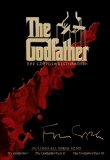| Reviews & Columns |
|
Reviews DVD TV on DVD Blu-ray 4K UHD International DVDs In Theaters Reviews by Studio Video Games Features Collector Series DVDs Easter Egg Database Interviews DVD Talk Radio Feature Articles Columns Anime Talk DVD Savant Horror DVDs The M.O.D. Squad Art House HD Talk Silent DVD
|
DVD Talk Forum |
|
|
| Resources |
|
DVD Price Search Customer Service #'s RCE Info Links |
|
Columns
|
|
|
Godfather - The Coppola Restoration Giftset, The
THE MOVIE:
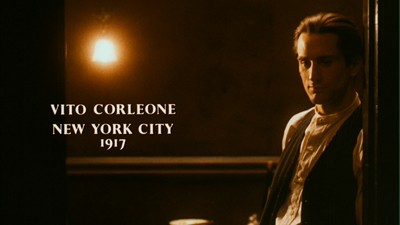
Reviewing The Godfather trilogy is a little like reviewing the Bible. Its reputation is so large and so much has been said about it already, it's hard to imagine that there is anything I can write that will either add or detract from its cinematic legacy. It's also something that most people have already made up their minds about, and they either don't need or don't want convincing, whereas the lucky few who are coming to it for the first time really need to make the journey on their own and decide for themselves. Are you prepared to let Vito Corleone into your heart?
Let's be honest, there are few things in life that live up to their hype, and even when they do, there is always some naysayer standing in the shadows waiting for his or her chance to be contradictory. Even Casablanca and Citizen Kane have their detractors. Those people are wrong, of course, but being wrong has never stopped anyone. They'd be wrong about The Godfather, too, if they chose to diss it. It's a movie series that has endured for a reason. Mario Puzo and Francis Ford Coppola have created a true American Epic, traversing the majority of the 20th century, telling the story of this country and its promise through the eyes of immigrants. Immigrants that happen to be gangsters, mind you. That's the hook. As I've written before, America loves its outlaws. From our nation's rebellious youth when cantankerous early Americans fought off the British fatherland and on through the frontier days and its two-gun anti-heroes, our myths have been full of individualists going against the grain. The birth of movies helped birth new mythologies, and with it, new anti-heroes in the form of gangsters: Paul Muni as Scarface, James Cagney as Cody Jarrett and Rocky Sullivan, and Edward G. Robinson as Rico, a.k.a. Little Caesar. It's an obsession that has endured, taking us all the way to today and James Gandolfini as Tony Soprano.
And The Godfather trilogy was a real touchstone of the gangster genre, a summation of the experience up through the 1970s when the first two installments were released and then moving forward into the 1980s when the third dropped in 1990. There is a reason that the Sopranos crew constantly referenced the Coppola pictures: this was the only playbook they had to go by.
This is also why each new DVD release of the three films garners a wide array of attention. The first 2001 set was an instant hit, a cause to sing and dance and drink pitchers of wine. Sure, they weren't perfect, the picture was a little dirty, but we finally had The Godfather on DVD. The second release in 2005 wasn't much different, it just broke open the boxed set and released the movies on their own, finally rewarding the hold-outs who insisted they didn't need the third part of the serial. Yet, not much else had really changed.
Now, in 2008, we have the third collection, The Godfather - The Coppola Restoration. The director has undertaken a top to bottom clean-up job for his most famous movies, scrubbing them up and preparing transfers more in keeping with current technology and the quality the film series deserves. It's not a new set so much as an expansion of the old 2001 version, keeping the same extras and building on them. Basically, it's a jazzed-up reprinting that fixes the mistakes of the past and offers a little something more to the loyal fans who are looking to stick their bucket in the well once again.
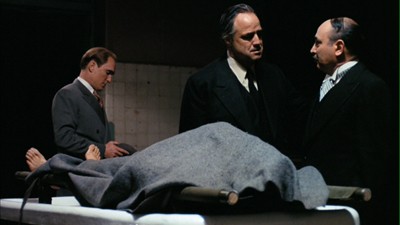
As a trilogy, The Godfather follows the standard structure, with each entry representing a specific act of the story. Part 1 is the establishment of something new, setting up the situation usually through a coming of age or a changing of the guard; Part 2 is longer, darker, more complicated, focusing on the struggle and transformation required for either victory or defeat in what is to come; Part 3 ties it all together, bringing us to either that victory or defeat. Since The Godfather is a tragedy, it's defeat that's waiting in the wings. In the final chapter, there must be some kind of accounting for the misdeeds of the past.
All three films stand individually, but they are constructed to be mirror images of one another. They share certain events and tropes, representing the continuous flow of crises and renewal, the shared history of the Corleone family being a tapestry of unchangeable fate. Each film begins with a family gathering of some kind, emphasizing what binds the clan together and how those connections are becoming frayed. In turn, each film ends with a bold action from Michael Corleone (Al Pacino), who above all is the focal character of the series. He is the reluctant Godfather, always trying to find a way out of his duty but never escaping the family business. In religious terms (yes, back to the Bible analogy), he is Jesus perpetually stuck in the Garden of Gethsemane, praying to be released from the greater plan, but always being returned into bondage.
Religion is important in The Godfather. In all of the films, sacred events are used as cover for the sin of murder, be it the christening in episode I or the street fair in the flashbacks in II, when young Vito (Robert De Niro) goes after Fanucci (Gastone Moschin). Notice, too, in that latter scene, Fanucci gets an orange on his way to the assassin's bullet. Coppola often uses poetic imagery to tie together different events across this vast timeline. Oranges always foreshadow some kind of violence or death--older Vito (Marlon Brando) is getting oranges when he is shot, and later eating one when he eventually dies, in one of the most poignant death scenes in all of movie history. So, too, is Michael eating an orange when he is plotting various hits near the end of part II and again in the final scene of part III. Though not a recurring theme, one of my favorite images in the movie is in part I when Luca Brasi (Lenny Montana) is being strangled. Coppola steps out of the room and films the attack through a glass pane decorated with a fish pattern. Later, when Michael and Sonny (James Caan) and the others are informed of Luca's death, it's with one of the movie's most quoted lines: "Luca Brasi sleeps with the fishes."
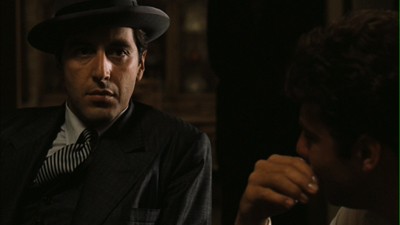
The Godfather was a hit book by Mario Puzo before it became a movie, and the adaptation was hotly anticipated when it was released in 1972. Francis Ford Coppola was a virtual unknown at the time, as was his main star, Al Pacino, whom Paramount famously did not want for the role. This series of films was really a flashpoint in terms of acting talent in the 1970s. Pacino, De Niro, Diane Keaton, Robert Duvall, John Cazale--many names were made off of the trilogy. With Marlon Brando presiding over the acting troupe, his passing the mantle of Godfather to Al Pacino in the first movie served the dual purpose of ushering in a new era of Hollywood, the way he and James Dean and other Actors Studio alums changed the landscape in the 1950s. (Actors Studio impresario Lee Strasberg even ends up playing an important role in Part II.)
The story begins in 1946. Michael's sister, Connie (Talia Shire), is getting married, and Michael has returned home from the war as a decorated veteran. His path has diverged from the rest of the Corleones. A thinker like his father, he was always expected to do his own thing and stay out of the family business. When an assassination attempt is made on Don Vito's life, and when the hotheaded Sonny throws fuel on the fire, causing the war between Mafia families to escalate, Michael eventually has to step in and take charge. The movie turns on his decision, and his character begins an unstoppable descent from the straight and narrow into everything he has so far avoided. He actually experiences the violent cycle first hand when his actions force him to hide out in Sicily, where the endless vendettas have practically wiped out the male population. Michael is touched by this vengeance when his American enemies catch up with him, putting an end to his romance with his young Sicilian bride (Simonetta Stefanelli).
When it comes down to it, Michael is the child most like his father: cold and calculating, with a mind wired for strategy and the will to execute it. Once he is back in the states, Michael takes more control, and by the end of the film, upon accepting the responsibility of being godfather to his nephew, he also accepts the responsibility of leading his family in full.
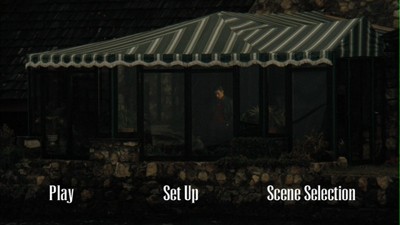
Given that The Godfather series began with having to live up to the popularity of the source novel, it would seem this series was practically designed with a built in need of having to exceed expectations. Huge box office and multiple Oscar wins meant that The Godfather: Part II couldn't be a by-numbers sequel. The 1974 picture is considered by most to be the best of the three. Coppola and Puzo took the challenge to heart and devised something bigger in scale and even richer in terms of history.
Part II opens in Sicily at the turn of the century. A nine-year-old Vito (Oreste Baldini) has lost his father, brother, and mother to the local mob boss, and he narrowly escapes his hometown of Corleone alive. Caring neighbors put him on a boat to Ellis Island, and the quiet child is forced to make his way in New York City alone. The rest of the movie plays out on two parallel timelines: Vito (De Niro) in the 1910s becoming a man and crossing over into a life of crime, and Michael in the 1950s becoming more ensconced in the business, expanding his empire, and learning the full breadth of the job he has taken on. The Corleones have moved from New York to Nevada, but Michael's plan for legitimacy seems to lumber forward in fits and starts. His family is drifting apart under his iron rule, and he is making decisions his father would never have approved of, something the old guard is quick to remind him. There is a lot of emphasis in both movies placed on the honesty of Vito Corleone, whereas Michael is seen time and again lying through his teeth. A promise of your safety from Michael only lasts until his men put the bullet in your skull.
While Vito slowly takes over his neighborhood racket, knocking out the previous boss to become boss himself, we watch Michael try to push the boundaries of his own business interests. This includes a move into Cuba to try to take over gambling and other entertainment concerns down there, and his failed maneuverings to deal with his enemies is neatly juxtaposed against Vito's return to Sicily to settle the score with the man who murdered his family. As the father gains more control, the son loses his, until Michael must once again resort to the violence he is trying to move away from in order to sew up all the gaps. Of course, the way he tries to seal those rifts only serves to create more. His way of protecting his family is more destructive than preservative.
The Godfather: Part II is full of masterful storytelling. Coppola moves between both timelines smoothly, never losing track of where he is or making his transitions willy nilly. The film is over three hours long--about 25 minutes longer than its predecessor--but it passes by without you ever noticing the length. It also manages to be both a prequel and a sequel at the same time, which could have been too much, but instead turns out to be just right. A lot of directors would have buckled under the weight, but Coppola somehow makes it look easy. I could watch this movie a million times and never get tired of it.
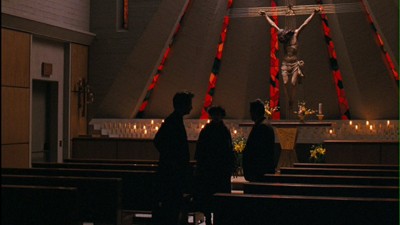
Sixteen years passed before The Godfather: Part III finally came to theatres, a surprising amount of time that had a lot of eyebrows raised. From a story standpoint, it makes sense, it allowed enough real time to pass for Coppola to move his story forward and take us into Michael Corleone's old age, jumping into the disco era of the late 1970s and moving into the 1980s, a decade of excess perfectly designed to allow a crime lord like Michael to find his long-desired legitimacy in the mainstream.
Despite having previously been the series that always defied the odds, this final installment of the trilogy never really stood a chance. It's like that new Guns 'n' Roses album that perpetually doesn't come out. Is there any way for Axl Rose to make it good enough to gobble up all that accumulated expectation? The conventional take on The Godfather: Part III is that it's not very good, and I don't think that is really based on an honest assessment of the material. Think about it. What is the first thing anyone says when you mention the movie? "Oh, man, Sofia Coppola sucks in that." It's not really the most inclusive criticism, is it? Yet, that's the thing that we've all been told to believe, that young Sofia's performance is somehow the defining aspect of the movie, and the hoi polloi have lined up to accept it.
So, let's dispel with that myth first. Sofia Coppola is not as horrible as the chatter would have you believe. She's not necessarily good, either, she's really just average, and while, yes, average should not ever have been allowed to enter into the vocabulary in reference to The Godfather, let's lay the blame where it belongs: at the feet of her father, the director. Ask yourself, for instance, is it Elizabeth Berkeley's fault that she sucked in Showgirls, or Joe Eszterhas for writing a crappy script and Paul Verhoeven for not directing her so that she was better? Whatever failings The Godfather: Part III has, and that includes Sofia Coppola's less-than-great performance, is the fault of bad direction. Winona Ryder having stuck with the picture wouldn't have saved it. There were a lot of clunky choices made by the director in this movie, from spinning newspapers as expositional tools and otherwise indulging a need to over-explain to the drift toward conventional soap opera in the teenage love affair subplot. It's not Coppola's finest hour behind the camera, and it drags the film down. (Kudos to Coppola for sticking by his daughter, though, and audaciously putting her face practically dead center in the design on the new The Coppola Restoration box.)
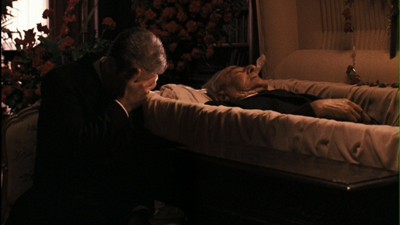
Had Coppola been at the peak of his powers, and not in a kind of slump after Gardens of Stone and Tucker (both decent movies), The Godfather: Part III could have been everything we hoped for. The script is actually very good, and it completes a lot of the themes and ideas advanced in the earlier entries. The final stage of Michael Corleone's life is a riff on King Lear. There are thunderous storms and the ongoing danger in the mobster lifestyle of not seeing who your true enemies are. Like in all of the movies, one must endure a sacrifice from within one's family in order to protect it. The son goes against the father, and a daughter's love commands the ultimate price.
Michael Corleone has succeeded in transferring all of his financial interests into completely legitimate businesses. Unfortunately, his former colleagues don't want to see the cash cow run off to greener pastures if they aren't still going to enjoy a share of the profits. After surviving an attack by small-time enforcer Joey Zasa (Joe Mantegna), a character whose lifestyle and comeuppance deliberately recall Fanucci from Part II, Michael and his nephew, Vincent Mancini (Andy Garcia), the illegitimate offspring of Sonny, try to root out who was backing Zasa. Meanwhile, Michael tries to go forward with a deal to take over an international conglomerate connected to the Vatican. As he has discovered, the upper echelons of organized religion and big business are as corrupt as organized crime.
The Godfather: Part III is about an old man whose dark life has left him no options for escaping his past. Though he seeks redemption and wishes to see his children surpass him, as the famous line goes, "Just when I thought I was out...they pull me back in." Naturally, this means the final installment is going to be more contemplative than the first two. His health is failing, and he sees his own mortality. (Ironically, here orange juice becomes an elixir to stave off death, serving to replenish Michael's blood sugar during a diabetic attack.) Thus, Michael reflects on his past, his discretions against his brother, his lost loves. He tries to make peace with his wife Kay (Diane Keaton), and he lets his son Anthony (Franc D'Ambrosio) pursue his dreams as an opera singer. He must also prepare for the transfer of power, the ascendance of a new generation, whether he likes it or not.
The chess game Michael plays in Part III involves different players than the previous chapters. Businessmen and boardroom deals don't have the same romantic oomph as thugs, hoods, and backroom negotiations, which could be another reason that people weren't as enamored of this finale as the films setting it up. Too much talk of stocks and shares, not enough bada-bing. Still, I think time will be kind to The Godfather: Part III, particularly as more people watch the films back-to-back on DVD. I think it makes for a satisfying finish to the saga, winding up the grand opera of the Corleone family in ways consistent with the tone of the original film.
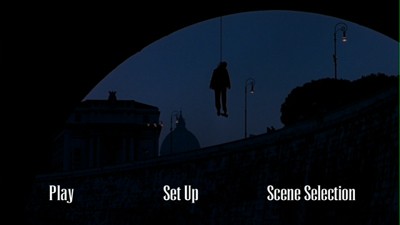
THE DVD
Video:
For The Godfather - The Coppola Restoration, the director oversaw a massive clean-up job that removed all the scratches and dirt that made the earlier DVDs less than what they should have been. Watching the movies again, they look brand new. Not a hair is out of place, no speck of dust has been left behind. It's the cleanest these films have likely looked since their initial minting.
As far as the look of the movies, it appears Coppola and his team have done some color correcting, brightening the image quality to achieve a warmer, more natural appearance than was on previous DVDs. The films still show the qualities of their original film stock, particularly on the first two installments, which means you will see some graininess and a lack of that silvery sheen that we get with contemporary movies, but this shouldn't necessarily be seen as a flaw. Boosting the image quality to try to match what we see in the latest Shia LeBeouf vehicle would be a mistake; The Godfather was never meant to look like that. This is a classic vintage we're tasting here. Of course, this also means that there is not a greater level of detail apparent in the picture, which may disappoint some who were expecting great revelations to come in this Hi-Def age. Then again, a new printing of Shakespeare with a better font won't likely turn up previously unseen commas either, so why worry?
As for the digital element of the transfer, I see no problems with how the movies have been ported to disc. Even with The Godfather Part II now being only one DVD instead of two, the restoration team has avoided any compression issues, and you'd be hard pressed to find any problems with the resolution.
Below find screen grabs from all three movies, captured as close to the same mark as possible, showcasing both the 2001 and 2008 versions, so you can see for yourself. There will most likely be some who prefer the older boxed set because it is colder and darker, reflecting the grayness of the morality in the movies as well as perhaps how they better remember the series from previous viewings; the choice is yours, dear consumer. Please note, though, that the process of capturing the images, shrinking them, and uploading them does wash them out slightly.
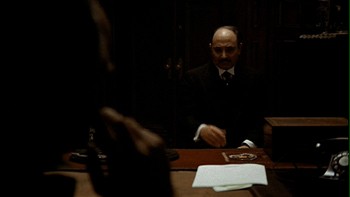
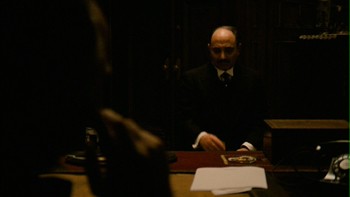
Godfather: Part I - 2001 vs. 2008
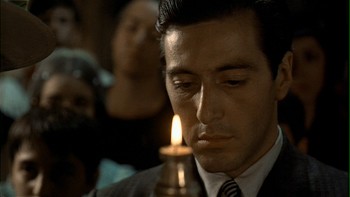
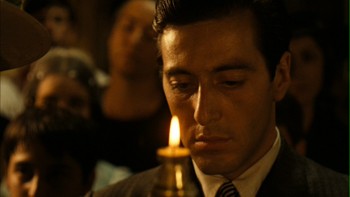
Godfather: Part I - 2001 vs. 2008
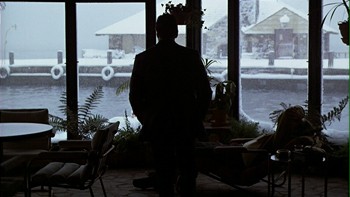
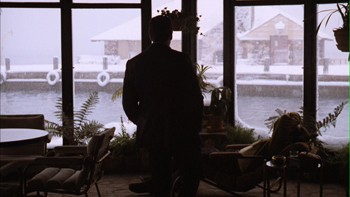
Godfather: Part II - 2001 vs. 2008
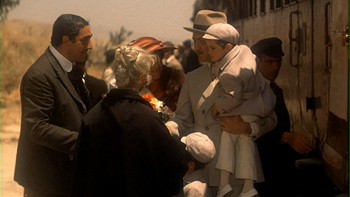
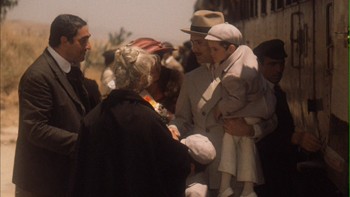
Godfather: Part II - 2001 vs. 2008
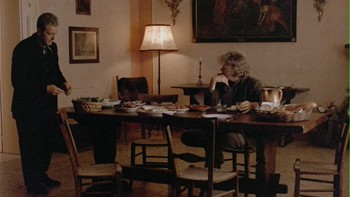
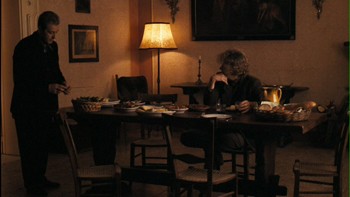
Godfather: Part III - 2001 vs. 2008
Sound:
The old Godfather DVD Collection was no slouch in the audio department, boasting a Dolby Digital 5.1 surround mix. The Godfather - The Coppola Restoration also has a 5.1 mix, but like the picture, it has been entirely remastered. Where I really noticed a change was in the sound effects, which now come through with much more clarity and force. The popping of a cork on a wine bottle has as much of an impact as a gunshot, and the big orchestral crescendos should rattle your windows with their might.
Another upgrade will please our French-speaking readers, with the French dub being upgraded from mono to 5.1, as well; whereas soundtrack purists will be glad to hear that the original English mono, which should more closely resemble what was heard in theatres, has also been added.
Subtitle options are French, Spanish, and English Closed Captioning. The 2001 collection only had English.
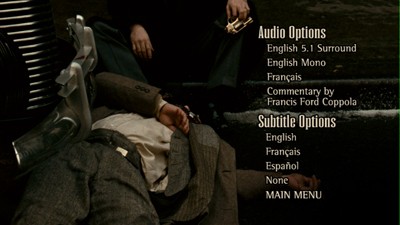
Extras:
One thing I will complain about in terms of this new set is that The Godfather - The Coppola Restoration Giftset packaging is not nearly as nice as the 2001 The Godfather DVD Collection. The original release came in a box designed to simulate a leather case with sparsely designed "booklets" to hold each movie. It looked like a classy collection of an important film series. The new edition is much more conventional, with a standard outer box and the five DVDs housed in four individual slim plastic cases. The images on the individual covers use essentially the same iconography as the old set, but they've been mocked up with all the standard information you would need for buying the movies individually--which, given that all of these films are coming out on their own on the same day as the big set, it's clearly a shortcut to avoid having to do any special design for the higher-ticket version.
Both boxed sets for The Godfather come with exclusive bonus discs, and all of the extras from the old set are transferred over here. This includes the full-length audio commentaries with Francis Ford Coppola on all three main discs. These are excellent, informative commentaries. With movies of this size, Coppola has much to talk about, including the perils of trying to keep the first film afloat, recreating the success for the sequel, and even the negative reactions the third installment garnered. They are great tracks, opening up the Corleone world in terms of fact (the production) and fiction (the story) for the franchise's fans.
Here I should note one major production flaw in the Coppola Restoration set, at least as it occurs in the copy I received. The supplemental features are broken up over two discs. DVD 4 is labeled "2001 Archival Supplements" and DVD 5 is labeled "All-New 2008 Supplements." The only thing is, the discs are mislabeled. My 2001 disc (DVD 4) had the 2008 extras, and vice versa. That's a big oops! (It remains to be seen if this is an isolated incident, a limited error, or on all of the discs.)
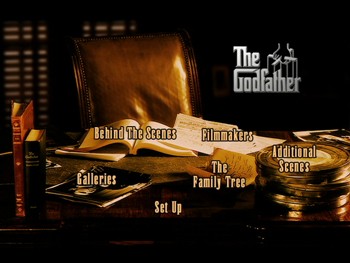
Once the discs have loaded, though, I guess that doesn't matter. The first disc has the carry-overs from the 2001 bonus DVD, and it includes the following features:
* Making of The Godfather: The 73-minute documentary looking at the making of the series, with lots of behind-the-scenes footage and rehearsal tapes sitting alongside interviews with Coppola and many of the actors, including Al Pacino.
* Additional Scenes/The Godfather Historical Timeline: 35 deleted scenes of various lengths, set up in sections and in chronological order to match the periods of the story in which they take place.
* Filming Locations: Production designer Dean Tavoularis takes viewers back to some of the locations where the first film was shot. (6 minutes)
* Francis Ford Coppola's Notebook: 10 minutes with the director showing us his preparation for the movie.
* Puzo and Coppola On Screenwriting: A collection of interviews regarding the collaborative writing process, as well as audio tapes from meetings the pair had to discuss story.
* Gordon Willis On Cinematography: A short discussion with Willis regarding the look of the picture. (4 min.)
* Original 1971 Behind-the-Scenes Featurette: Vintage promotional piece. (9 min.)
* The Corleone Family Tree: Text-based bios of the principal characters.
* The Music of The Godfather: An audio interview with Italian composer Nino Rota, as well as a short piece on Carmine Coppola, who added additional music. (3 min.)
* Acclaim and Response: A text-based list of awards the movie was nominated for, four clips of footage of various Academy Award acceptance speeches, and the 1974 television broadcast introduction.
* Trailers for all three films.
* Profiles on the Filmmakers: Another text-based biography feature.
* Photo Galleries & Storyboards: Galleries taking us behind the scenes. The storyboards are only from the first two movies.
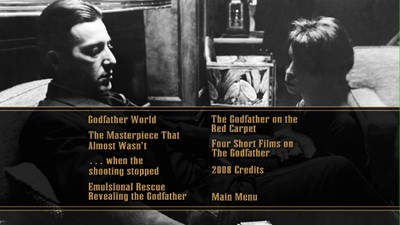
The second disc of supplements, created exclusively for the 2008 set, are as follows:
* Godfather World: An examination of the lingering impact of the series, with admirers David Chase (creator of The Sopranos, and featuring scenes from the show that reference the movies), Alec Baldwin, William Friedkin, Richard Belzer, Trey Parker (featuring a parody clip from South Park), Guillermo del Toro, Steven Spielberg, and others. There are also spoof clips from Family Guy, The Simpsons (with Joe Mantegna talking about Fat Tony), SCTV, the films You've Got Mail and Analyze This, and even that horrible Robert Evans cartoon Kid Notorious. (11 minutes)
* The Masterpiece that Almost Wasn't: Oops, shouldn't have evoked the name of Robert Evans! He shows up with a bunch of commentators--William Friedkin, George Lucas, Walter Murch, Steven Spielberg, and, of course, Francis Ford Coppola--all discussing the changes going on in Hollywood at the end of the 1960s, with the feeling that the movie industry was ending and how a new guard eventually moved in. This, of course, includes Evans' reign at Paramount (the subject of much of the great documentary The Kid Stays in the Picture, clips of which are used here), and how the studio execs did not want to make The Godfather. This is followed by some material on the reaction to the movie, including comments from admirers John Turturro, Richard Belzer, Alec Baldwin, director Kimberley Peirce, and others who saw it on release. (30 minutes)
* When the Shooting Stopped: Anecdotes from the post-production period, including editing and music, cut from the same cloth as the preceding featurettes, while also adding people like co-editor Richard Marks. There is much dissection of the film's dramatic style, as well, carrying into a discussion of the two sequels. (14 minutes, 15 seconds)
* Emulsional Rescue: Revealing The Godfather: 19 minutes on the restoration process and describing the original color and lighting design that this endeavor was trying to restore. Features interviews with director of photography Gordon Willis and restoration technicians. This includes very technical talk and picture comparisons.
* The Godfather on the Red Carpet: An inexplicable four-minute extra asking various lower-tier actors and professionals going to see Cloverfield what they think of the movies and showing these guys riffing on famous lines. This includes performers like Harold and Kumar's John Cho, Species-gal Natasha Henstridge, and people who I guess are going to be in the next Star Trek movie...? Lizzie Caplan acting out the "abortion scene" is one of the more embarrassing things I've seen in a while.
Finally, there are Four Short Films on The Godfather, which are exactly that, four short films relating to The Godfather. They are essentially compiled of unused bits from the interviews from the larger features. These little programs are:
* GF vs. GF Part II : People expressing their belief that Part II was the superior of the first movies and why. (2:12)
* Riffing on the Riffing: Richard Belzer challenging another guy (he's not credited again in this one, and I'm too lazy to look him up in the longer piece) with lines from The Godfather and seeing if he can come up with the right response. (1:37)
* Cannoli: Coppola discusses why he wrote the bit with and the cannoli and how the famous lines surrounding it came about. (1:38)
* Clemenza: Coppola reads the explanation of Clemenza's demise from a trivia book about the movie, and then explains the real reason why he decided to leave the elder gangster out of the second movie. (1:40)
All in all, the new extras aren't entirely essential, but the first four are at least of decent enough substance that if they were on their own, I'd give them pretty solid marks. I give the producers credit for trying to add more to the mix without being lazy about it and resorting to things like commercials for the more recent Godfather franchise cash-ins like video games and comic books.
FINAL THOUGHTS:
The Godfather - The Coppola Restoration--what can I say? It's The Godfather. These movies are monumental, and this new set is the version we should have gotten seven years ago. Debates over the color palette aside, this restoration job cleans up the movies and makes them look brand new. Couple that with the fact that the already excellent extras now have a few new siblings to go with them, and this is, at last, the comprehensive Godfather collection cineastes have been clamoring for. When it comes down to arguments over what movies belong in every movie fan's collection, The Godfather will always make the list, and The Coppola Restoration Giftset is finally the DVD set-up to match the series' reputation. DVD Talk Collector Series.
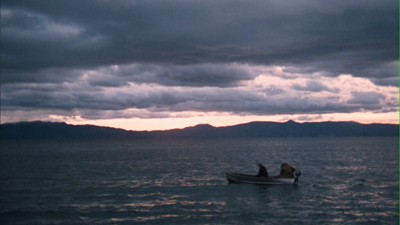
Jamie S. Rich is a novelist and comic book writer. He is best known for his collaborations with Joelle Jones, including the hardboiled crime comic book You Have Killed Me, the challenging romance 12 Reasons Why I Love Her, and the 2007 prose novel Have You Seen the Horizon Lately?, for which Jones did the cover. All three were published by Oni Press. His most recent projects include the futuristic romance A Boy and a Girl with Natalie Nourigat; Archer Coe and the Thousand Natural Shocks, a loopy crime tale drawn by Dan Christensen; and the horror miniseries Madame Frankenstein, a collaboration with Megan Levens. Follow Rich's blog at Confessions123.com.
|
| Popular Reviews |
| Sponsored Links |
|
|
| Sponsored Links |
|
|
| Release List | Reviews | Shop | Newsletter | Forum | DVD Giveaways | Blu-Ray | Advertise |
|
Copyright 2024 DVDTalk.com All Rights Reserved. Legal Info, Privacy Policy, Terms of Use,
Manage Preferences,
Your Privacy Choices | |||||||









